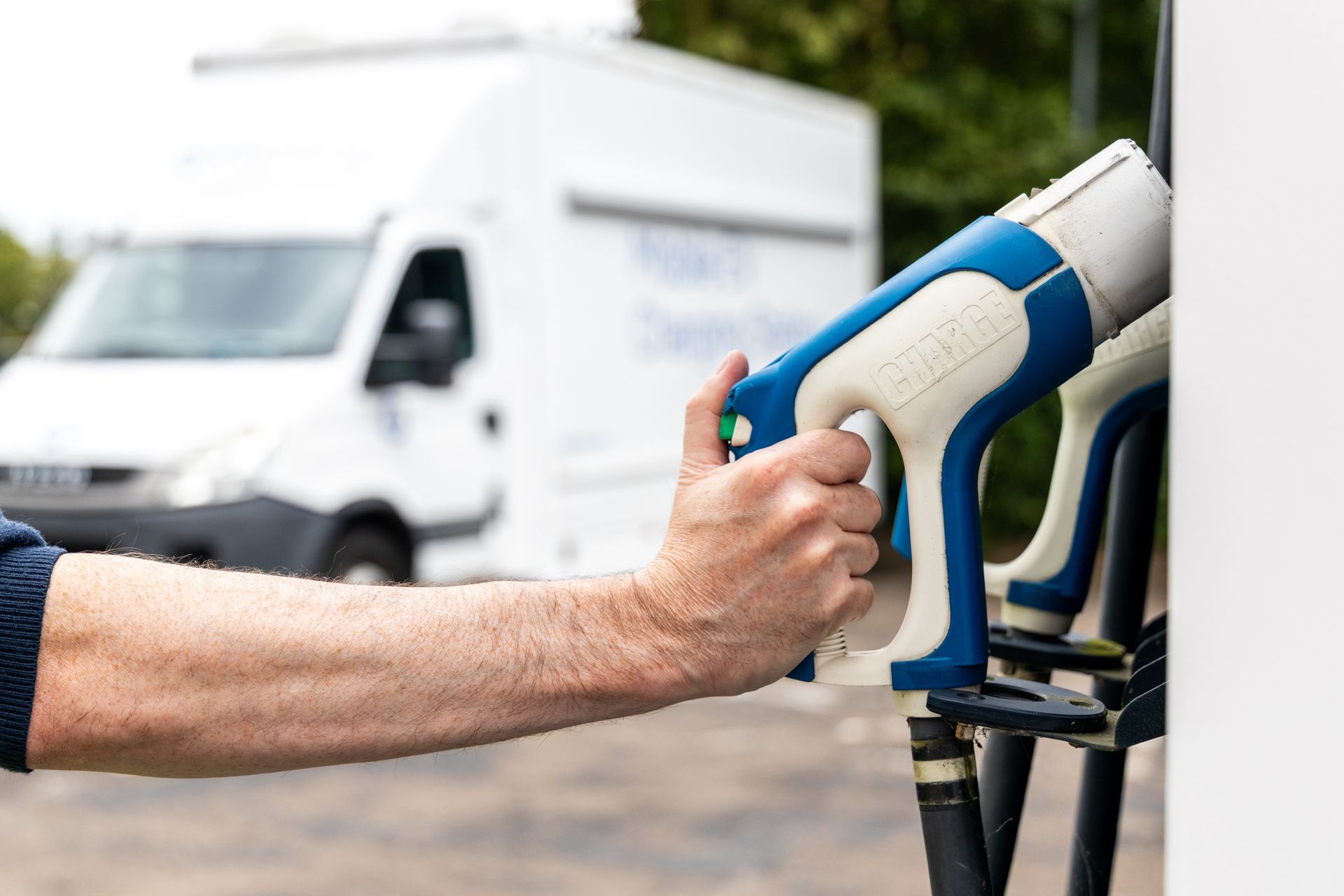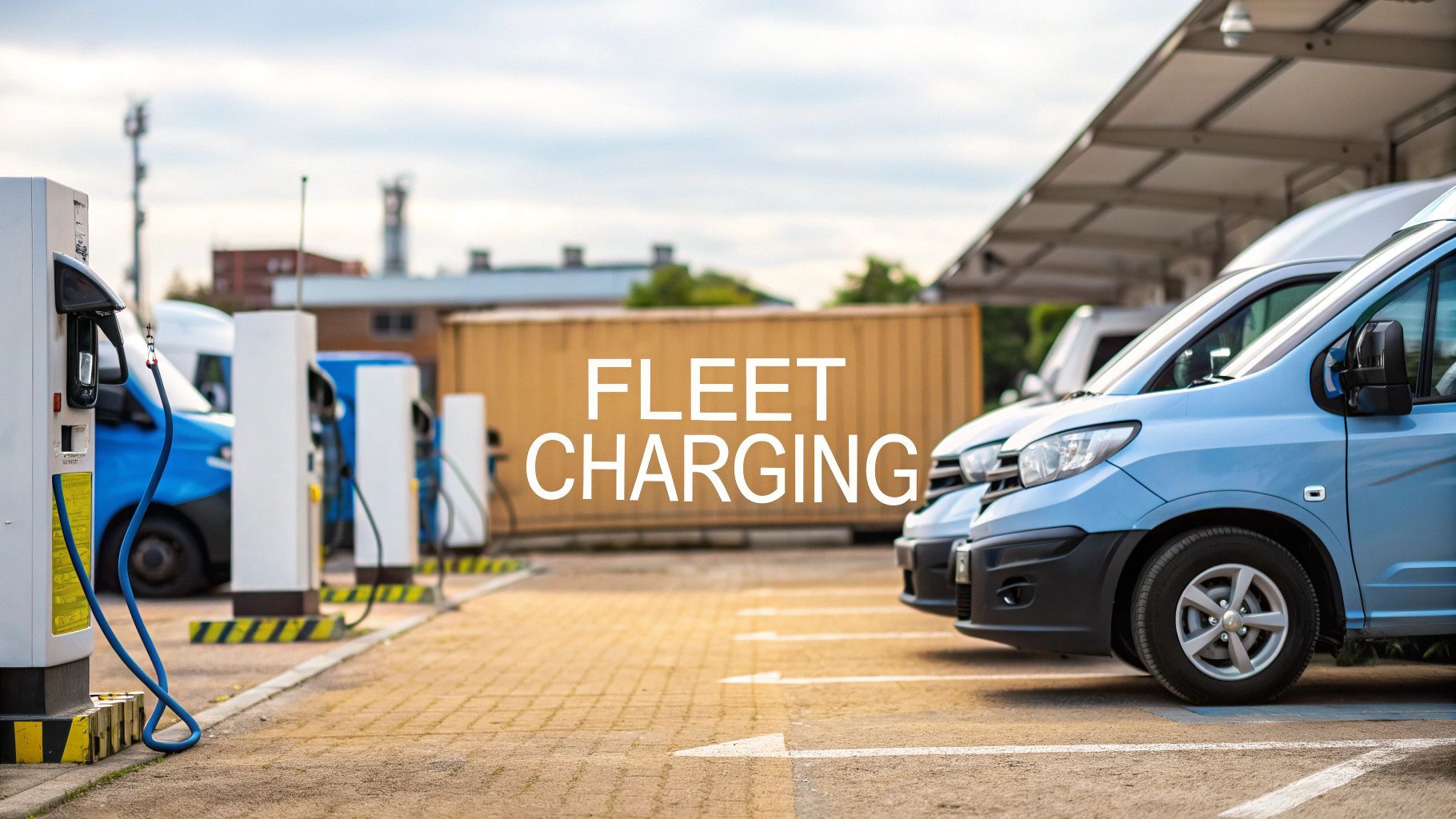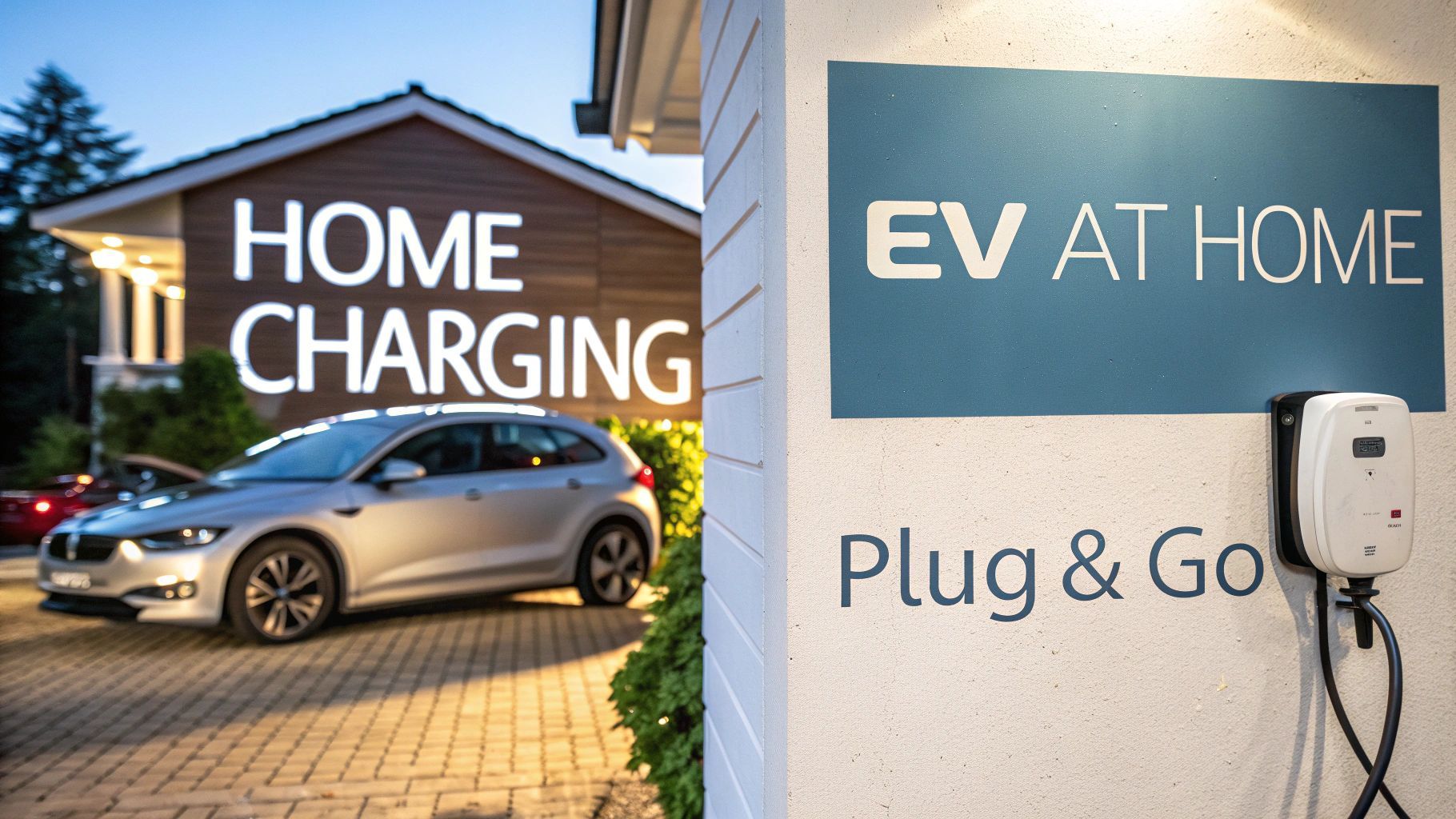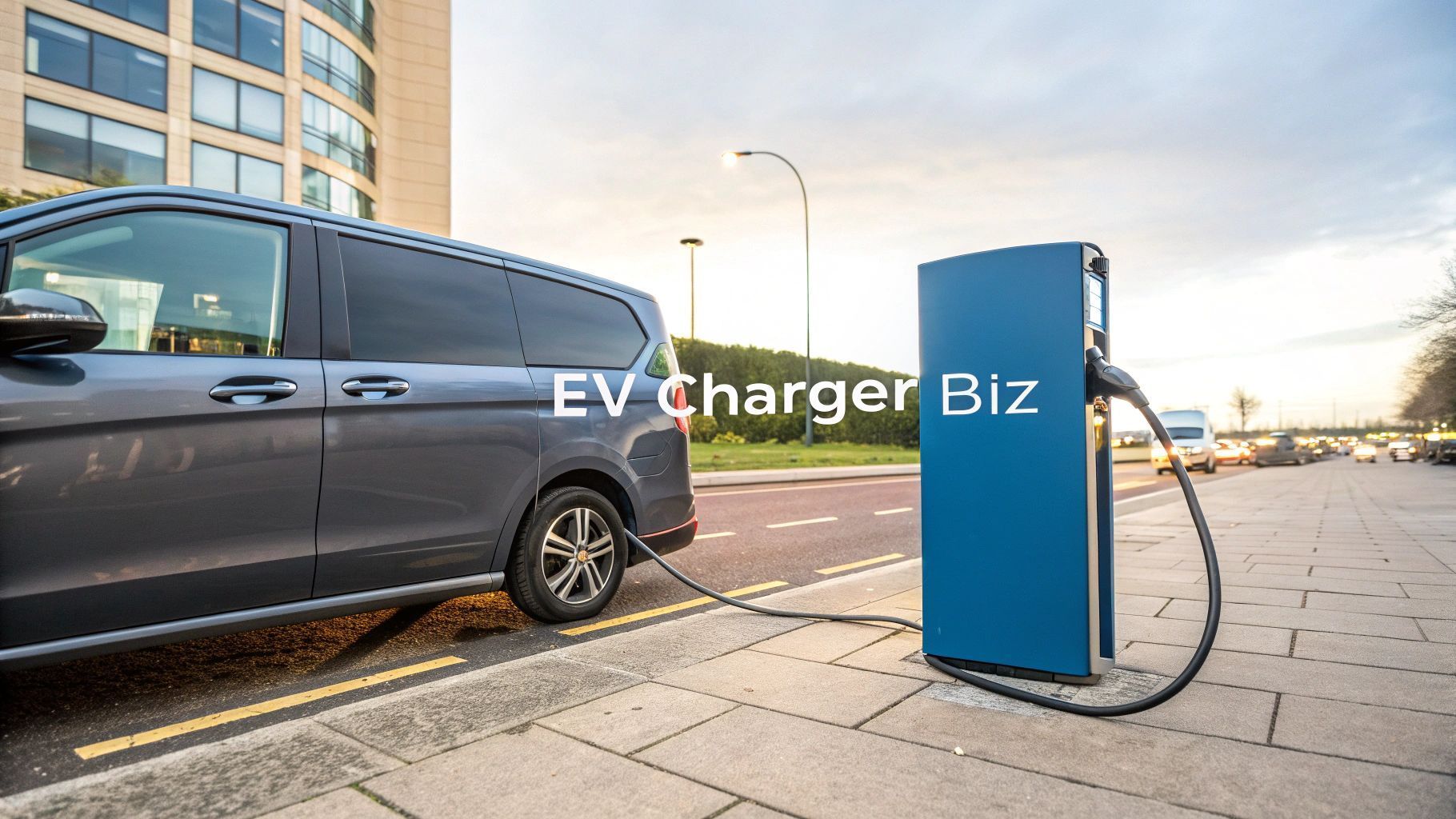A Guide to Battery Packs for Car Charging in the UK
Think of a battery pack for car charging as a jerrycan of electricity for the modern age. These powerful, portable units—often called mobile EV chargers—are designed to give an electric vehicle (EV) a meaningful charge, wherever it happens to be.
They are a lifeline for a driver who has run out of juice, a convenient top-up away from a fixed charge point and a fantastic answer to the dreaded "range anxiety." For entrepreneurs, they also represent a serious business opportunity in the UK's fast-growing EV market.
The Growing Power of Mobile EV Charging
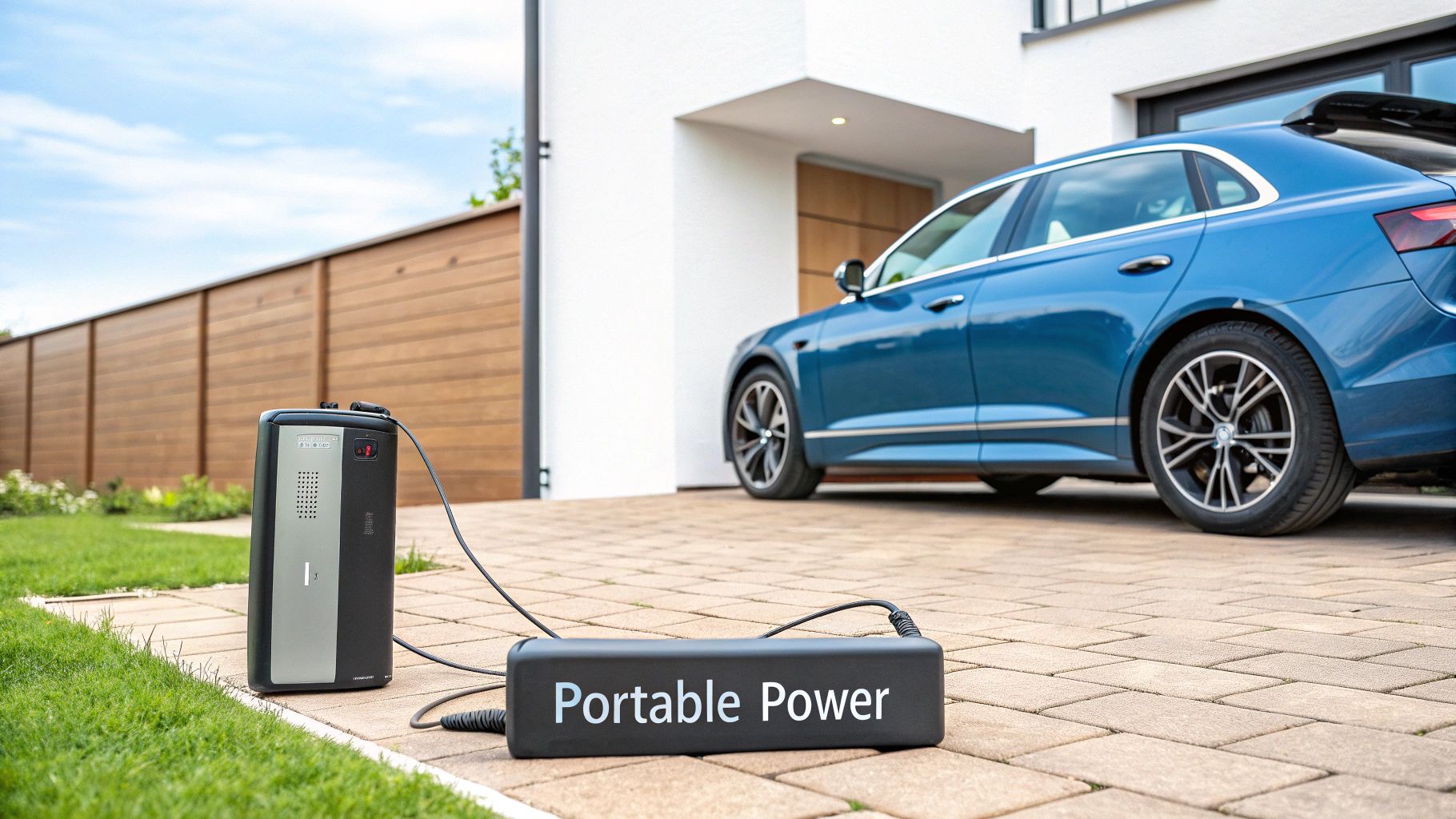
Range anxiety is still a very real thing for a lot of UK drivers. The fear of finding the nearest public charger broken, busy or just too far away can be a genuine roadblock for people thinking about switching to an EV. This is exactly the problem a battery pack for car charging solves.
But these units are much more than just an emergency backup. They are a flexible and potent solution for drivers and a golden opportunity for forward-thinking business owners.
A Solution For A Growing Market
The UK’s shift to electric cars is picking up serious speed. By mid-2025, there were already over 1.6 million battery electric vehicles on UK roads and that number is climbing every single month.
While the public charging network has expanded to over 84,000 charge points, there are still gaps in coverage and reliability issues. This is especially true for the 32.8% of UK households that do not have access to their own off-street parking.
This explosion in EV ownership creates an immediate and obvious demand for on-the-go charging services that the fixed network just cannot always meet.
The Business Of On-Demand Power
For a business operator, a mobile charger opens up a whole new revenue stream by offering a premium service built on convenience. The earning potential is huge, driven by the ability to charge a call-out fee on top of a competitive per-kWh rate for the electricity itself.
This model allows an operator to:
- Provide emergency roadside assistance to stranded EV drivers.
- Offer convenient top-ups at places without chargers, like hotels, wedding venues or remote holiday cottages.
- Set up contracts with businesses to provide workplace charging for staff or fleet vehicles.
The real magic of mobile EV charging is that you bring the power directly to the customer. They do not have to find a static charge point and wait their turn. That convenience is an incredibly powerful selling point and a major advantage for any mobile charging business.
Bringing energy right to the customer’s doorstep is a game-changer, a concept that has already proven successful with services like convenient mobile gas delivery services. By tapping into this fundamental need for flexibility, operators can build a profitable business that plugs a critical gap in the market and helps the nation move towards electric mobility.
How Mobile EV Chargers Actually Work
So, what is really going on inside one of these portable battery packs for car charging? It is tempting to think of them as a mysterious black box but the reality is far simpler. The technology is a clever and logical combination of proven components, all working together to deliver power right where you need it.
Think of it as a massively scaled-up version of the power bank you might carry for your phone.
At its heart, the system is built around high-capacity lithium-ion battery cells —the very same fundamental technology that powers the electric vehicle it is designed to charge. These individual cells are grouped into large modules to store a serious amount of electrical energy, ready to be deployed at a moment's notice. This part is essentially the fuel tank, holding all that potential energy.
The Brains Behind The Power
Of course, you cannot just dump all that energy into a car at once. The entire operation is managed by a sophisticated bit of kit called the Battery Management System (BMS) . The BMS is the intelligent traffic controller for all the electricity flowing into, out of and within the battery pack. It is constantly monitoring crucial factors like the temperature of the cells, their voltage and the current being drawn.
This constant supervision is absolutely vital for two key reasons. First, it ensures the whole process is completely safe by preventing overheating or overcharging. Second, it maximises the long-term health and lifespan of the battery cells, which protects the owner's investment and guarantees reliable performance for years.
The image below breaks down the simple, three-step process of turning stored energy into a vehicle charge.
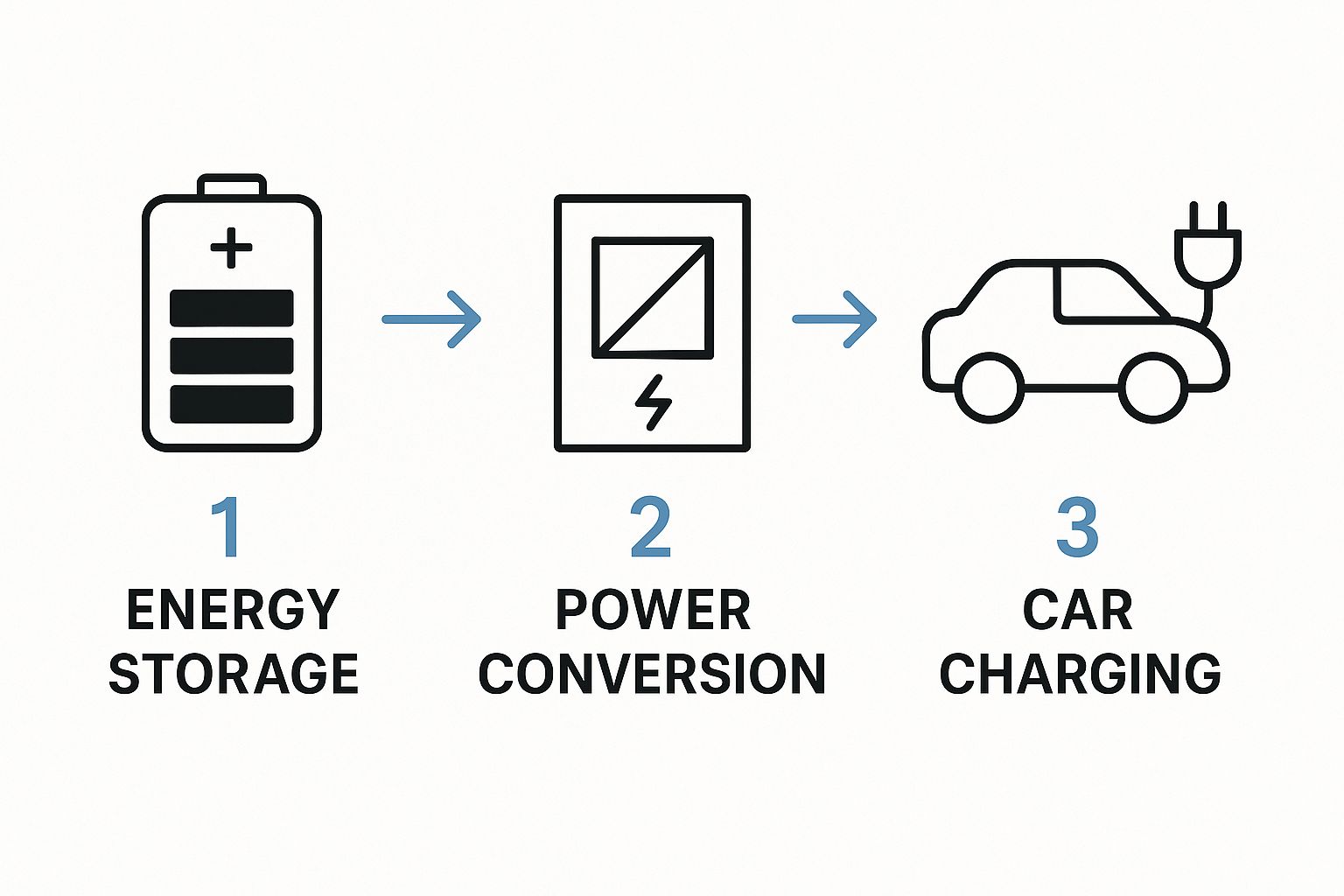
This flow really highlights how the raw, stored energy is safely managed, converted and then delivered to the vehicle in a controlled, logical sequence.
From Stored Energy To A Charged Car
Once the BMS gives the all-clear, the stored energy needs one final tweak. The battery cells hold their power as Direct Current (DC) but many vehicles—especially for slower top-ups—need Alternating Current (AC). A component called an inverter handles this crucial conversion seamlessly inside the unit.
Finally, all that power is delivered to the vehicle through standard, industry-compliant charging cables and connectors. In the UK, this almost always means a Type 2 or CCS (Combined Charging System) connector, ensuring it is compatible with the vast majority of EVs you see on the roads today.
By combining these proven technologies—energy storage, intelligent management and power conversion—a mobile charger delivers a safe, reliable and incredibly flexible charging solution.
This self-contained ecosystem is what makes mobile charging a practical reality. For anyone curious about the specifics of these powerful units, you can learn more about the technology inside ZAPME's rapid mobile chargers on their website. It is this smart integration of components that turns a simple battery into a fully-fledged, go-anywhere EV charging station.
The Key Advantages of Going Mobile
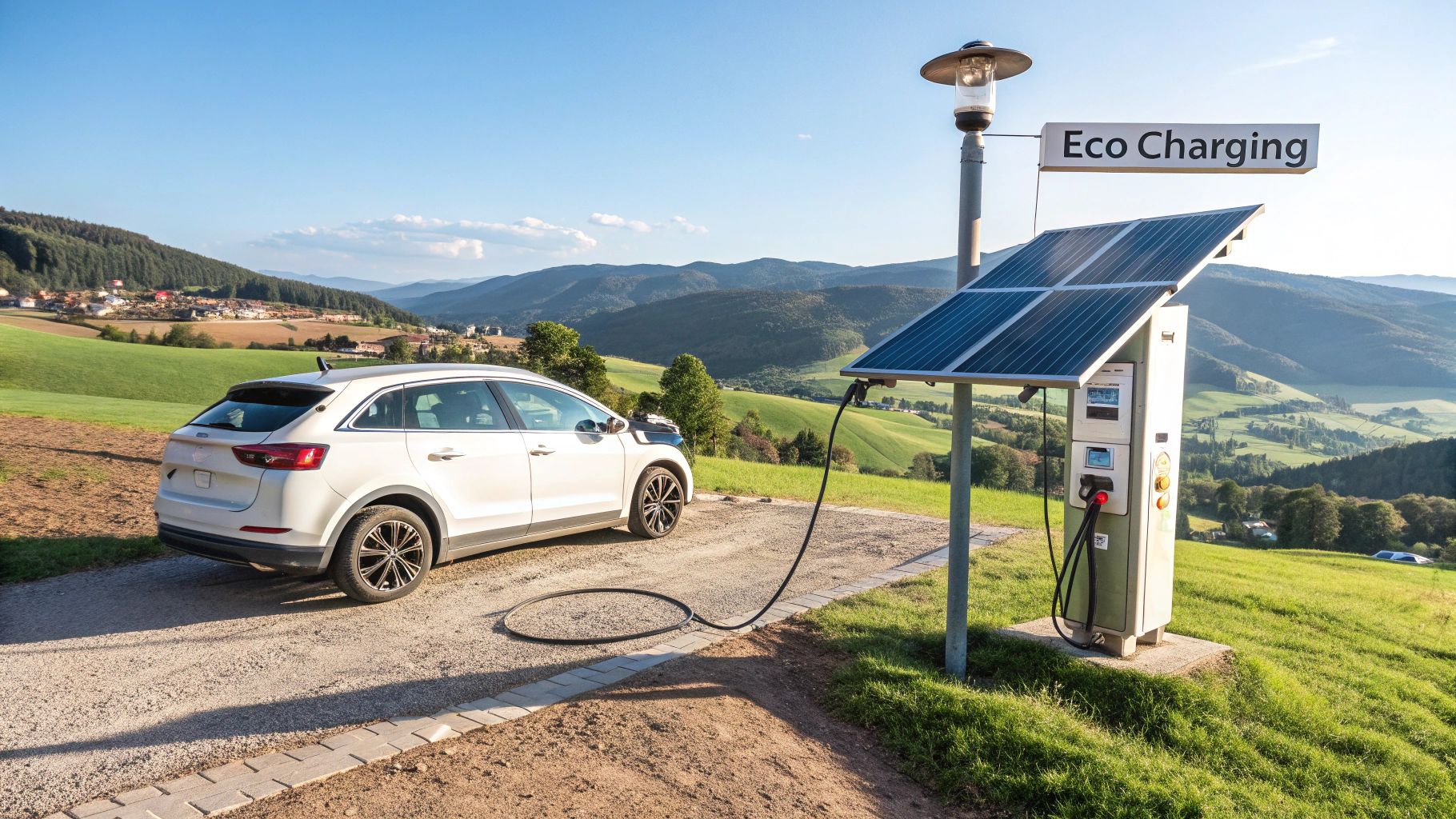
A battery pack for car charging is a game-changer, not just for drivers but for business owners too. For any EV driver, it is the ultimate source of freedom and peace of mind. You are no longer tethered to the fixed charging network.
Imagine being able to top up your car at a remote holiday cottage, a festival field or a countryside wedding. More importantly, it is a lifeline if you find yourself stranded with a flat battery miles from anywhere. Think of it as the modern equivalent of a spare can of petrol, just without the fumes or the fire risk.
A Lucrative Business Opportunity
For entrepreneurs, the advantages are even clearer. Mobile charging lets you launch a service without the huge capital investment, lengthy planning permissions and fixed overheads that come with installing permanent charge points. That agility is a massive strategic benefit, making it a highly profitable venture.
This flexibility means you can go where the demand is. You are not tied to a single spot; instead, you can serve multiple sites, from business parks during the week to event venues at the weekend. It allows you to offer a premium, on-demand service that customers are more than happy to pay for, creating a significant income stream for an operator.
This model fits the rapidly expanding UK market perfectly. As the number of battery electric vehicles on British roads grows, the demand for flexible charging is soaring. By April 2025, BEVs had captured a 20.4% market share of new car registrations—an 8.1% increase year-on-year. It is a clear sign of the electric shift and the growing need for versatile charging infrastructure.
The Financial Upside of Mobile Operations
The real appeal for an operator is the strong revenue potential. By cutting out the cost and complexity of fixed installations, you can build a profitable business with a much lower initial outlay. Your entire operation is contained within a vehicle, ready to go wherever it is needed most.
The core value is simple: convenience delivered directly to the customer. An operator can build diverse revenue streams by targeting different markets with a single, flexible asset, leading to substantial earnings.
This versatility opens up several obvious routes to profitability:
- Emergency Roadside Assistance: This is a high-margin service. You can charge a call-out fee plus a per-kWh rate to rescue stranded drivers, generating immediate and significant revenue.
- Fleet Charging Contracts: Businesses with EV fleets need reliable charging. You can offer scheduled top-ups at their depots, making sure their vehicles are always ready for the road and securing a steady income.
- Event and Hospitality Partnerships: Work with hotels, wedding venues and festival organisers to provide temporary charging, creating an essential amenity for their guests and a lucrative contract for your business.
- Residential Top-ups: Serve customers in apartment blocks or homes without driveways who struggle with convenient charging access, tapping into a consistent and growing market.
The ability to operate anywhere creates a dynamic and resilient business model. Looking beyond EV charging, the power of this mobile approach is clear and you can learn more by unlocking the benefits of mobile access in other sectors. This is what makes a mobile charging business such a compelling proposition.
Building Your Mobile Charging Business
Investing in a battery pack for car charging is much more than just buying a piece of kit; it is the first step toward building a flexible and potentially profitable business. For anyone thinking about becoming an operator, the big question is always the same: how much money can you really make? The answer is not just about a single service but about creating a mix of reliable revenue streams that fit the UK market.
The most obvious route is the roadside assistance model. When an EV driver gets stranded with a flat battery, you are the emergency service they call. This service usually involves a call-out fee plus a rate for every kilowatt-hour (kWh) of energy you supply. Because it is an emergency, you are providing immediate, high-value help, which means you can set your prices to reflect that and maximise your earnings.
Developing Your Revenue Models
But one-off emergency calls are just the beginning. The real key to long-term success is building contracts and partnerships. This is how you shift from being a reactive, on-call service to a proactive and essential partner for other businesses. The opportunities here are huge and they are what allow you to generate a steady, predictable income.
Just think about these potential avenues:
- Fleet Charging Contracts: Team up with local businesses that run fleets of electric vans or cars. You can offer scheduled charging at their depot, maybe every morning or evening, making sure their vehicles are always topped up. They get a fully charged fleet without the headache and cost of installing their own fixed chargers. This provides a reliable monthly income.
- Business Park Subscriptions: Set up a subscription model for companies located in a business park. Their employees can book a convenient charge while they are at their desks. It is a fantastic perk for the employees and a solid, recurring revenue stream for you.
- Event Partnerships: Get in touch with organisers of festivals, outdoor weddings or big corporate events. Providing temporary EV charging on-site is an indispensable service for attendees. You could charge guests directly or negotiate a flat fee with the event organiser, creating a highly profitable one-off job.
The core opportunity is to turn your mobile charging unit into a versatile asset that serves multiple markets. From emergency call-outs to corporate contracts, a single operator can build a significant income by filling a crucial gap in the UK’s EV infrastructure.
For a more detailed breakdown of the numbers, it is worth exploring the economics of mobile EV charging. It gives a great overview of how different models can be structured for the best returns.
A Hypothetical Business Case
To bring this to life, let us sketch out a quick business case. Your initial investment will cover the mobile battery pack, a suitable vehicle (like a van), insurance and some basic marketing to get your name out there. Yes, there are start-up costs but the potential return on that investment is compelling.
Let us picture an operator working in a medium-sized UK city. They decide to mix things up. By securing just one small fleet contract and handling a few private call-outs or scheduled top-ups each day, the revenue can start to stack up surprisingly fast.
Hypothetical Earnings for a Mobile Charging Operator
This table illustrates a potential monthly revenue model for a single mobile charging unit operator in a UK city, based on industry-standard pricing.
| Service Type | Charges per Day (Avg.) | Price per Charge (£) | Monthly Revenue (£) |
|---|---|---|---|
| Emergency Roadside Assistance | 1 | £75 | £2,250 |
| Scheduled Residential Top-up | 2 | £40 | £2,400 |
| Small Fleet Contract | 3 | £30 | £2,700 |
| Total | 6 | - | £7,350 |
This hybrid model gives you the best of both worlds: the stability of contract work combined with the higher margins from on-demand services. It is a formula for building a financially sound business, all from a single vehicle.
Choosing the Right Battery Pack for Your Needs

Picking the right mobile battery pack for car charging is a big decision. It is one that will directly shape how successful your service can be. Whether you are launching a full-scale commercial operation or just want a dependable backup for emergencies, getting to grips with the key specs is the only way to make a smart choice.
At the heart of any unit are two metrics that really matter: battery capacity and charging speed. These two factors work in tandem, defining what your charger can actually do out there in the real world.
Understanding Capacity and Speed
Think of battery capacity, measured in kilowatt-hours ( kWh ), as the size of a fuel tank. It dictates how much total energy the pack can hold and in turn, how many cars you can service before the unit itself needs a recharge. A higher kWh rating means more jobs done throughout the day.
Charging speed, measured in kilowatts ( kW ), is all about how quickly you can get that energy into a vehicle. It is like the flow rate of the nozzle at a petrol station. A higher kW output lets you add more miles of range in less time, which keeps customers happy and lets you get to your next job faster.
The best units find the sweet spot between capacity and speed. A massive capacity is no use if the delivery is too slow for your customers’ needs and a super-fast charger is not much good if it can only manage one small top-up before it is empty.
Key Factors for the UK Market
Beyond those core numbers, a few practical points are vital, especially for anyone operating in the UK. Weighing these up carefully will make sure your investment works for you today and tomorrow.
- Portability and Form Factor: You have got to consider the unit’s physical size and weight. A smaller, lighter pack might be fine for stashing in a car boot but a commercial operator will need a more robust, van-mounted system like the ZAPME MAX 300 mobile charger to deliver serious power.
- Connector Types: Your unit has to be fitted with the right plugs for the UK’s vehicle market. That means having both CCS (Combined Charging System) and Type 2 compatibility to serve the vast majority of EVs on the road.
- The Cost-Benefit Trade-Off: High-capacity, high-speed units open up the greatest earning potential but they naturally come with a bigger price tag. It is all about balancing your budget with your business plan.
The UK's drive to electrify its cars and vans is creating huge demand for these solutions. With the government aiming for all new car and van sales to be zero-emission by 2035 and corporate fleets leading the way, the need for advanced battery pack technology is only growing. This market shift is exactly why choosing the right gear now is so critical for long-term success.
Common Questions About Mobile EV Charging
As the idea of a battery pack for car charging on the move becomes more familiar, it is only natural that questions pop up. Whether you are an EV driver wondering about the practicalities or a business owner weighing up the opportunity, clear answers are essential. Here, we tackle some of the most common queries.
Our aim is to give you straightforward, practical information that explains how these systems really work out on the road.
How Long Does It Take to Charge an EV?
This is the big one but the answer is not a single number. How long a charge takes comes down to two things: the power output of the mobile charging unit (measured in kW) and the size and current state of the car's battery. It is worth remembering that these units are not designed to be as ferociously fast as a fixed ultra-rapid charger.
To give you a real-world idea, a typical 20kW mobile charger could add around 60-70 miles of range to an average family EV in about an hour. That makes it perfect for a meaningful emergency top-up or for convenient destination charging where a driver might be parked for a while anyway.
Are Mobile EV Charging Battery Packs Safe?
Yes, absolutely. Reputable, commercial-grade units are built with layer upon layer of safety features to protect both the operator and the vehicle being charged. At the heart of it all is the Battery Management System (BMS) .
Think of the BMS as the unit's brain. It constantly monitors temperature, voltage and current to catch any potential issues long before they can develop. On top of that, these units must meet strict UK and EU safety certifications to be sold and operated legally, which ensures they are just as safe as any fixed charging point you will find on the street.
Can I Charge Any Electric Car?
Compatibility is a massive design focus for any good mobile charger. These units are built to be as universal as possible, which means they come equipped with the standard connectors used right across the UK and Europe.
The vast majority of electric vehicles on British roads today use either a CCS (Combined Charging System) or a Type 2 connector. A professional mobile charging pack will have both, covering everything from Teslas and VW IDs to Nissan Leafs and Polestars, making the service useful to almost any EV driver.
This broad compatibility is non-negotiable for any operator wanting to serve the entire market. It means that when a call for help comes in, you can be confident you have got the right tool for the job.
How Much Do Commercial-Grade Units Cost?
The investment needed for a commercial-grade battery pack for car charging really depends on its capabilities. The main things that influence the price are its total battery capacity (kWh) and its maximum power output (kW).
An entry-level commercial unit, perhaps suited for basic roadside assistance, might start in the region of £5,000 to £10,000 . At the other end of the scale, larger, more powerful van-mounted systems designed to charge multiple vehicles or deliver faster top-ups can cost upwards of £30,000 . Ultimately, the cost is directly tied to the unit's earning potential and the scale of the service you are looking to offer.
At ZAPME , we provide pioneering mobile charging solutions designed in the UK to meet the demands of drivers and fleet operators. To discover how our technology can power your mobile charging business, visit us at https://www.zapme.biz.

